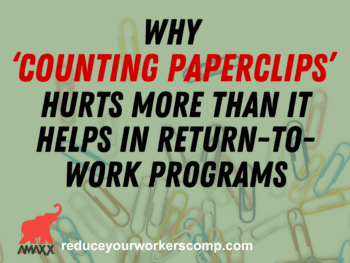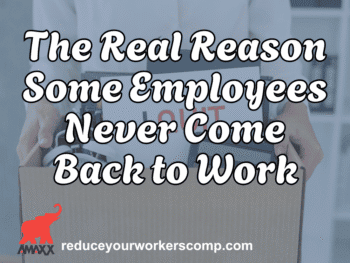Kansas High Court Strikes Down Requirement that Injured Workers Make Good-Faith Effort to Find Appropriate Work Following Injuries How Would You Decide?Here’s what Tom Robinson, J.D., writer for Lexis Nexis Workers’ Comp Law Center reports.
Here’s What Happened
Bergstrom worked as a production janitor for an employer, a manufacturer of plastic plumbing parts. She began to experience pain in her back after picking up a heavy garbage can. She experienced severe pain the following day and was told to see a nurse practitioner, who prescribed pain medication. Bergstrom was assigned to a less strenuous job, sorting parts, but was unable to do the job because she could not sit and bend for an extended time.
She then saw an orthopedic specialist, who told her to stop working and apply for Social Security benefits. She saw a number of other physicians, including another orthopedic surgeon and a psychologist. Later, she attempted to return to work for the employer, but was assigned to a position where she experienced severe back and leg pain after three hours. She left work and was terminated by the employer.
After several hearings, the administrative law judge awarded some permanent disability, but the Board reduced the award to a ten percent permanent partial disability (PPD) to her body as a whole, concluding that Bergstrom had not exercised good faith when she failed to perform alternate job duties the employer offered her after her injury. Bergstrom contended the Board erred when it applied a good-faith effort requirement not contained in K.S.A. 44-510e.
K.S.A. 44-510e generally provides PPD should be expressed as a percentage to which the employee, in the opinion of the physician, has lost the ability to perform the work tasks that the employee performed in any substantial gainful employment during the fifteen-year period preceding the accident, averaged together with the difference between the average weekly wage the worker was earning at the time of the injury and the average weekly wage the worker earned after the injury.
The statute also provides an employee shall not be entitled to receive PPD compensation in excess of the percentage of functional impairment as long as the employee is engaging in any work for wages equal to 90% or more of the average gross weekly wage that the employee was earning at the time of the injury. The Board indicated it had followed several Court of Appeals decisions that required a good faith effort be exerted when considering post-injury job searches. Here the Board found that Bergstrom had not put forth a good faith.
Here’s How the Court RuledHere’s How the Court Ruled
In Bergstrom v. Spears Mfg. Co., 2009 Kan. LEXIS 838 (September 4, 2009), in a split decision, the Supreme Court of Kansas, on transfer from the state Court of Appeals, reversed and remanded in relevant part. Initially, the majority noted that in Foulk v. Colonial Terrace, 20 Kan. App. 2d 277, 284, 887 P.2d 140 (1994), rev. denied 257 Kan. 1091 (1995), the Kansas Court of Appeals had examined the legislative intent underlying K.S.A. 1988 Supp. 44-510e(a) and had concluded that the statute implicitly contained a requirement that injured workers exercise good faith in attempting to mitigate their wages lost to work impairments. The majority observed that in Copeland v. Johnson Group, Inc., 24 Kan. App. 2d 306, 320, 944 P.2d 179 (1997), the Court of Appeals expanded on its ruling in Foulk. The majority said that under Copeland, the fact finder was required to make a determination as to whether the injured worker had made a good faith effort to find appropriate employment. If a finding was made that a good faith effort had not been made, the fact finder was directed to determine an appropriate post-injury wage based on all the evidence before it, including expert testimony concerning the worker’s capacity to earn wages.
The majority indicated that it could find nothing in the language of K.S.A. 44-510e(a) that required an injured worker to make a good-faith effort to seek out and accept alternate employment. The majority observed that the legislature had provided for a means to compare the worker’s pre-injury and post-injury earnings, coupled with a percentage of impairment determined by a medical professional. It had further placed a limitation on PPD compensation when the employee “is engaging in any work for wages equal to 90% or more of the average gross weekly wage that the employee was earning at the time of the injury” [K.S.A. 44-510e(a)]. The legislature had not required the employee to attempt to work.
According to the majority, Foulk and Copeland had been decided contrary to the principle that an appellate court must give effect only to express statutory language, rather than speculating what the law should or should not be. The majority said it would not add something to a statute not readily found in it. (workersxzcompxzkit)
Chief Justice McFarland dissented, noting that if the Court of Appeals in Foulk incorrectly read legislative intent into the statute, the legislature had certainly had the opportunity to correct that error at some point in the 15 legislative sessions since the Foulk decision. The chief justice argued that this was even more compelling in the workers’ compensation context since-according to the chief justice-there was perhaps no other statutory scheme subject to such constant legislative scrutiny than the state’s Workers’ Compensation Act. McFarland indicated that within the 2005-2006 legislative session, more than 80 bills related to workers’ compensation had been introduced. He concluded that participants in the workers’ compensation system should have stability and predictability in the law, yet the majority failed to consider such reliance “in cavalierly overruling a 15-year-old statutory construction for no reason other than it would have applied the rules of statutory construction differently if faced with the issue in the first instance.”
See generally Larson’s Workers’ Compensation Law, § 81.01.
Tom Robinson, J.D. is the primary upkeep writer for Larson’s Workers’ Compensation Law (LexisNexis) and Larson’s Workers’ Compensation, Desk Edition (LexisNexis). He is a contributing writer for California Compensation Cases (LexisNexis) and Benefits Review Board – Longshore Reporter(LexisNexis), and is a contributing author to New York Workers’ Compensation Handbook(LexisNexis). Robinson is an authority in the area of workers’ compensation and we are happy to have him as a Guest Contributor to Workers’ Comp Kit Blog. Tom can be reached at: compwriter@gmail.com.
http://law.lexisnexis.com/practiceareas/Workers-Compensation
WC IQ Test: http://www.workerscompkit.com/intro/
WC Calculator: www.reduceyourworkerscomp.com/calculator.php
Follow Us On Twitter: www.twitter.com/WorkersCompKit
Do not use this information without independent verification. All state laws vary. You should consult with your insurance broker about workers’ comp insurance issues.
©2008 Amaxx Risk Solutions, Inc. All rights reserved under International Copyright Law. If you would like permission to reprint this material, contact Info@WorkersCompKit.com
















